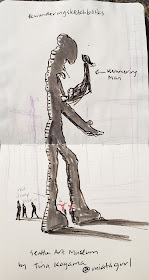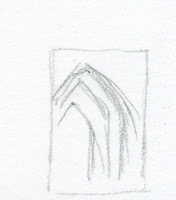 |
| Vintage Rexel Cumberland Derwent Drawing Pencils |
In using and reviewing vintage colored pencils, I most often conclude that older products are not
necessarily better, at least in terms of function. Esthetically, they are
frequently more beautiful in appearance, with greater care taken for design
(which is one reason I enjoy collecting them). On the inside, however, older
colored pencils generally contain less pigment and come in far fewer hues. As
pencil-manufacturing technology has improved over time and as art materials, in
general, have become of higher quality, I’ve found contemporary products to be
superior. (One notable exception is Prismacolor.)
I recently realized that one of my all-time favorite
contemporary pencils has a core that has been of the same high quality all
along – when I serendipitously discovered its vintage incarnation.
A while back I reviewed the Derwent Drawing Pencil, which is my favorite for life drawing
sessions. It has the thickest and softest core of any colored pencil I’ve
tried, which makes it ideal for the broad strokes and shading that I like to do
during both short- and longer-pose drawings. I call it a colored pencil, but
its range is limited to only 24 natural hues that are probably intended for landscapes and human skin.
When I first spotted a set of vintage Rexel Cumberland Derwent Drawing Pencils on eBay, it didn’t even occur to me
that they might be the same as the contemporary ones I use at life drawing.
Some are in the form of broad, flat carpenter pencils, and others are round.
All display a beautiful natural finish. I was told that these pencils went out
of production around 2000. (The set also came with three graphite carpenter
pencils in grades HB through 4B which, disappointingly, are not as smooth as I
wish they were.)
 |
| Carpenter-style pencils |
When I read some of the color names – Chocolate, Terracotta,
Venetian Red – a little bell rang over my head: Where have I seen those color
names before? Of course – the Derwent Drawing Pencils!
As I began knife-sharpening the carpenter pencils (an
immensely satisfying process that is probably as close to whittling as I will
ever come), I saw that the cores looked very similar to their modern sisters.
 |
| I love sharpening these! |
Some test scribbles indicated that they do, indeed, have the
same soft cores I know and love!
 |
| The same cores as their modern sisters. |
Contemporary Derwent Drawing Pencils have round barrels
painted to look somewhat similar to the stained natural wood grain of the
vintage ones, but it’s obvious that the wood is not the same. (I won’t even
mention the chipped end caps that modern Derwent pencils consistently display
after very little use [but you can see them here]).
 |
The two pencils at left are contemporary Derwent Drawing Pencils;
the others are vintage (carpenter style) |
So while their exterior quality and design have gone
downhill over time, I’m very happy to report that their cores have always been
the same. In the carpenter pencil form, which exposes a core with a wide range
of line widths, they are even better for life drawing.
 |
| Look at those fat, juicy cores! |
Edited 2/1/19: Serendipitously, a friend just gave me the Derwent
Drawing Pencil below, which, at first glance, looks like the currently available design
– painted barrel with end cap. But it still has the unpainted natural finish of the vintage pencils with
the addition of the modern end cap (and true to form, the end cap paint is chipped!).
The imprint says Derwent instead of Rexel Cumberland. My guess is that this
design was transitional between the vintage and the contemporary designs.
 |
| Modern Derwent Drawing Pencil with natural finish |
 |
| Modern Derwent Drawing Pencil -- and mandatory chipped end cap! |
 |
| 1/17/19 Alex (10-min. pose) |
 |
| 1/17/19 5-min. pose |
 |
| 1/17/19 2-min. pose |

















































